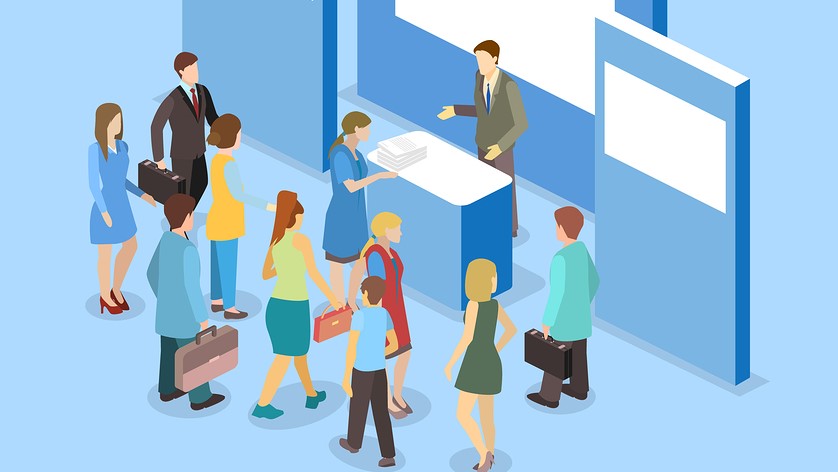Many people think of trade shows as mega events for large companies. However, there are many regional and local events geared toward small and mid-sized businesses. If your company is considering participating in small trade shows or table top events, and you don’t already have a plan in place, here are some helpful tips to consider:
Before Saying YES, Define Your Purpose
Having something as seemingly simple as a “table” at a table top event requires planning and an investment of time and money. The stakes get higher with larger shows and events. Before saying YES to having a table or booth at a show or event, be sure to clearly define your purpose and establish goals.
Are you there to raise awareness for your company or to sell products at the show? Is your primary goal to gather leads or set appointments? Have you been offered a table or booth in exchange for being a sponsor of an event and want to maximize the opportunity?
It’s important to define your goals about what you hope to achieve and develop a plan to maximize the investment of your time and money. Companies that plan to participate in numerous events and shows need to develop a system to gauge success and measure their return on investment (ROI).
Plan Your Pre-Event and Post-Event Marketing
How do you plan to market your involvement BEFORE you exhibit at the show? It could be as simple as promoting your involvement on social media and sending out emails to your existing contacts to invite them to the event. For larger shows, you might get lists of registered attendees to contact via email and snail mail prior to the conference. You might want to advertise in the trade show directory or through other targeted platforms.
How do you plan to follow up AFTER the show? In my many years of experience, I’ve heard stories of companies going to large national shows and blowing their marketing budget because they didn’t have a solid plan for follow up after the event. Ouch! If you are going to spend the time and money for ANY level of trade show or table top event marketing, you need to have a plan for follow up after the event. Follow up activities could include social media posts, emails, calls, appointments, snail mail and adding prospects into a system for ongoing follow up.
Develop a Capture System & Lead Qualification System for the Event
Once you are at the show, how are you planning to capture information on your visitors? Larger shows often provide a list of all registered attendees. Some shows offer badge scanning tools to collect data from people who visit the booth. For smaller shows, it’s generally up to the exhibitor to figure out how to get contact information for follow up after the show. People are often reluctant to give this information freely, so you need to get creative.
As a point of caution, not all contacts are good prospects for most businesses, so you need ways to “qualify” them. For example, if your company offers home remodeling services, then people renting properties would not be good prospects (unless they planned to purchase a home in the very near future). In this scenario, if the remodeling company offered a drawing for a $250 gift card (a generic prize anyone could use) they would likely get contact information from many unqualified prospects. However, if they offered a voucher for $250 of home repairs (only valuable to a home owner), they would likely get more home owners registering for a chance to win.
Invest in Materials to Attract and Engage People at the Show
As you invest in materials for the show, consider how often you plan to participate in table top events and trade shows. If this is a big part of your marketing plan, then you want to budget accordingly. If you are just displaying at a table top event because you received a spot in exchange for a sponsorship, then you would want to be more conservative in spending.
In a “sea” of tables or booths, you need to figure out how to attract people to your display and get them to interact with you. Here are some ideas:
Table Skirt or Banner
Most small shows and table top events provide a table, two chairs and table skirt as part of the package. If you want to add your own branding, you can have a banner printed and attach it over the skirt to show your logo and company name. (I’ve used grommets, velcro, binder clips and other materials to “secure” banners over skirts, but be sure to test your system before the show.) For a more professional look, you can have a custom table skirt printed with your logo and branding.
Custom Backdrops, Roll Up Banners, Pop Up Displays and Presentation Boards on Easels
If you are planning to participate in lots of shows, you will want to invest in quality trade show materials. However, before you hire a professional designer and/or trade show display company, be sure to attend similar shows and evaluate the best (and worst) in displays and take pictures for your reference. Again, take into consideration your primary purpose in exhibiting at the shows and make sure your materials will help you achieve those goals. If you only plan to do a table top event occasionally, displaying presentation boards on easels can be an inexpensive solution.
Collateral Materials, Business Cards, Brochures & More
In my experience, most materials collected at trade shows go directly into the garbage shortly after the show. Business cards, one-page flyers and tri-fold brochures are more cost effective as handouts, but you can have a supply of more detailed information for people who show a sincere interest. (However, I think it is best to use these detailed materials as a follow up after the show.) You can also save an electronic brochure in the form of a PDF on a thumb drive and give those to good prospects.
Selling Items or Setting Appointments at the Show
If you have a product you are selling at the show, make sure you have adequate inventory on hand and/or have system for easily processing and shipping future orders. If your goal is to set appointments to visit people after the show, be sure to have a system for booking appointments and following up after the show.
Lure Them with Candy and Treats
I’ve seen companies large and small have baskets of candy and mints to attract people to their displays. If this makes sense for your business/industry, it is an easy way to help draw people to your table or booth.
Pens & Branded Promotional Items
Promotional items such as pens, mugs, cozies, squish balls and the like are often used at trade shows. You can order products via online sellers such as www.amsterdamprinting.com or www.pens.com or find a local promotional products representative to help you select items and place your orders.
Drawings for Prizes
In order to collect contact information, especially at shows where exhibitors do not automatically receive a list of attendees, it’s common to see people offering a drawing for a prize. You can collect business cards or have them to write down their number/email or fill out a simple form. It’s generally a good idea to promote the winner on social media (just make that a requirement for accepting the prize) and offering all other entrants some type of thank you in the form of a coupon, discount or free educational white paper that would be perceived as having value. (As mentioned earlier, when possible, customize your prizes to be more appealing to your target audience to gain more qualified prospects.)
Add an Interactive Feature
Interactive features let people engage with you to understand the product/solution. For example, I’ve represented Speedheat Floor Warming Systems for over 10 years. To demonstrate their floor warming products, I bring a demo unit that warms up, and I ask people to place their hand on the warm tile to experience the product. For your business, do you have any ways to illustrate your services or products in an interactive way?
 Create Something Photo Worthy for Social Sharing #LetsGetSocial
Create Something Photo Worthy for Social Sharing #LetsGetSocial
Is there a way to integrate a photo worthy element into your table or display? Social sharing can help you extend your reach beyond the show. One of my favorite examples is from an Atlanta magazine called My Home Improvement. At events such as the Atlanta Home Show, they bring a photo setup that features a backdrop with their magazine cover. They have a photographer that takes pictures of people in front of the backdrop, so it appears they are on the cover of the magazine. They print out a commemorative picture on the spot and post the pictures to their social media pages. Many people also continue to share their pictures on social media. It’s a brilliant example in my opinion. On a more limited scale, you could come up with a “selfie” frame or cutout or prop for people to use.
Leverage Technology to Explain Your Product or Service
Are there ways you could use a laptop, monitor or tablet to illustrate what you do? Videos explaining your product or solution, especially with testimonials can be very compelling. You can also do a series of scrolling images, pictures, 3-D models that run on a “loop” to add some visual excitement to your table.
Make Sure You Have Access to Electricity
If you need electricity to power ANYTHING at your table (even a phone charger), make sure you coordinate that with the trade show organizer (or that it is clearly listed in your contract). It’s generally a good idea to bring an extra extension cord and a power strip (just in case you need it). With large shows, there may be union requirements for designated workers to help with electricity. (Again, never take having access to electricity for granted.)
Theft Protection
Make sure you bring a friend to help guard the table if you step away OR make sure there is nothing that you would be devastated to lose if it were stolen.
Think Outside the Box
What if you want to do something different? In a situation where you have a 10 x 10 area with a table and two chairs, you can ask if you can push the table behind you and stand in front of the table (versus the traditional standing behind the table). Also, you could ask if you could bring in your own display or materials in lieu of the table and chairs (for example, if you created a unique unit/display for shows). Companies that participate in frequent trade shows often have elaborate custom display systems that take up large portions of the trade show floor and integrate technology and other unique features.
Pick a Few Ideas to Get Started
You don’t have to incorporate ALL the suggestions on the list! Just pick a few that make sense for your situation. With some proper planning and a little creativity, you will be better positioned to achieve success at your next show or event.
If you found this article helpful, please post a comment and share it on social media. Also, be sure to check out my other blog posts and connect with me on social media to help us stay in touch. Thank you!





